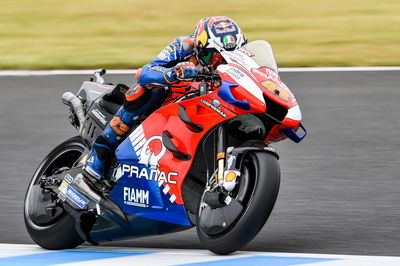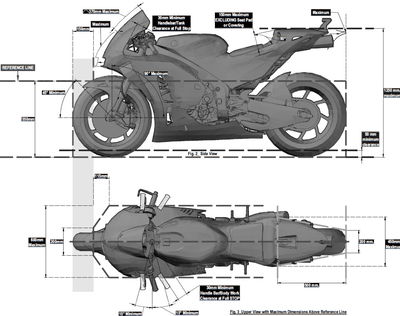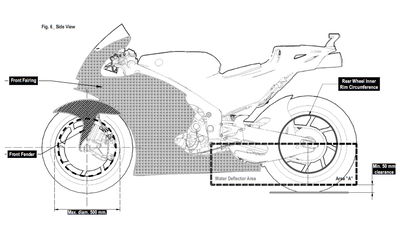2020 MotoGP aero changes published
The revised 2020 MotoGP aerodynamic rules, aimed at closing the kind of 'grey areas' that resulted in four rival manufacturers (unsuccessfully) protesting the Ducati swingarm device after last year's Qatar race, have now been published.

The revised 2020 MotoGP aerodynamic rules, aimed at closing the kind of 'grey areas' that resulted in four rival manufacturers (unsuccessfully) protesting the Ducati swingarm device after last year's Qatar race, have now been published.
As previously reported, the new rules confirm additional areas will now fall under the Aero Body rules, which allow only one aerodynamic update during the season. Bodywork dimensions are also more detailed while a new load test has been introduced to prevent moving aerodynamic devices.
A statement last July declared stricter aerodynamic rules had been agreed by all parties for 2020, but the exact wording of the changes has only recently been revealed. As ever, factories will update their aerodynamics over the winter, but the 2019-spec fairings should still pass the revised rules, while swingarm spoilers also remain legal…
Bodywork
New rules have been added at the start of the Bodywork section of the MotoGP rules, stating that any motorcycle chosen for technical verification "will be checked in the condition that it crosses the race finish line. Meaning, it will not be permitted to make any mechanical adjustments to the motorcycle."
Fully extended fork travel length for each machine must also now be declared before the opening round of the season, with a spacer/checking tool of that same size provided to the Technical Director.
When undergoing technical checks, the rear of the motorcycle "should be supported at the foot pegs only, with the rear wheel itself supported only by its own weight and have no more than 3mm of ground clearance."
The bike must also be held upright, with no lean angle.

In terms of overall MotoGP bodywork dimensions, these are now more specific, including a new "tapered area" to limit the growth of rear bodywork.
Any "unsprung parts of the rear suspension, and any part that moves as a consequence of the rear wheel suspension travel (e.g the swingarm, the rear mudguard, swingarm crash covers...), is not limited by the tapered rear body limits, but it is subjected to the specific 400 mm width limit, with the sole exception of round section rear wheel lift bolts.
"Swingarm covers that match the swingarm surface and are contained inside a 10 mm swingarm offset are not considered as parts of the Aero Body, if the swingarm itself is not part of the Aero Body."
The maximum motorcycle dimensions and outer profile of the upper and lower parts of the main fairing "will be controlled with a template of these dimensions, under conditions as detailed by the Technical Director."
Meanwhile, "Any attachment to the front suspension unsprung parts (e.g. brake rotors covers, calipers, cooling ducts…), with the exception of the Front Fender and the parts of the braking circuit (calipers, hoses), must be contained inside a horizontal cylinder."
To control the use of wheel covers, the old rules stated it must be possible to see "at least 180 degrees of the rear wheel rim" (no transparent material allowed) and "the whole of the front rim, other than the part obscured by the mudguard, forks, brake parts or removable air-intake."
The 2020 rules give a revised definition of the 180-degree figure, requiring a clear view of: "One or more portions of the rear wheel rim that, together with other parts not belonging to the Aero Body, make a total of at least 50% of the inner rim circumference."
The front wheel bodywork rules are unchanged, although the term 'rim' is now precisely defined ("circular portion of the wheel fitting the tyre, with the exception of hub and spokes").
A new rule on ground clearance has been added to the section preventing any motorcycle bodywork extending beyond "the edge of the rear tyre", which now states "or closer than 50 mm to the ground."
Moving aerodynamic devices
As reported, a new load test will be introduced in 2020 to prevent any attempts at dodging the ban on moving aerodynamic parts through deliberate flexing of the bodywork:
The new rules state: "Any part of the Aero Body, when mounted on the bike in normal operating condition, shall have a maximum deflection of 10 mm in any point, when a 50N vertical load is applied in the downward direction with a spherical 20 mm radius steel penetrator."
Any "active adjustability" through "linkages, bearings and any design that permits an intentional change in shape/orientation/position" is illegal.
Aero Body expansion
Previously, the Aero Body rules only applied to "the portion of the motorcycle bodywork that is directly impacted by the airflow while the motorcycle is moving forward, and is not in the wake of the rider’s body or any other motorcycle body parts."
In other words, just two areas; the fairing and front fender.
But from 2020, any part of the motorcycle "will automatically be considered as parts of the Aero Body" and collectively called " Other Aero Body Parts", if they:
"…Are not belonging to the Front Fairing or the Front Fender, but still are directly impacted by the airflow while the motorcycle is moving forward, and are not in the wake of the rider’s body or any other motorcycle body parts (e.g. handguards)."
"…Are located ahead of the rider and have a horizontal cross-section that is tapering towards the rear of the motorcycle (e.g. drop-shaped fork covers), with the exception of front suspension attachments."

'Area A'
In addition to "Other Aero Body Parts", a further new Aero Body region has been created to cover the lower half of the swingarm (where the Ducati tyre cooler, subsequently mirrored by rivals after its legality was confirmed, is located), called 'Area A'.
This is defined as a rectangle "extending between the swingarm pivot center to the back of the rear wheel, and between 50 mm to the ground and the real wheel spindle center".
Aero Body restrictions will thus apply to:
"… All the parts that in a side view belong, totally or in part, to area “A” and having design elements and/or portions that are not strictly necessary to let the rider control the machine (accelerating, braking, steering, gearshifting), or connect the two wheels with proper stiffness, allowing relative motion (suspension, steering), regardless they are structural (e.g. a monocoque swingarm that is shaped for extra functions) or not (e.g. a swingarm attachment)… with the exception of sensors, wiring harness, rear brake cooling ducts, and exhaust pipes and/or exhaust pipe covers that are contained in a 20 mm offset."
As before, only one update can be made to each part of the expanded Aero Body (now comprising the Front Fender, Front Fairing, Area “A” and Other Aero Body parts) during the season.
The new 'Area A' and 'Other Aero Body Parts' are "considered as one single component each". That means "any change in one of them is considered as an update".
The example given is "if a motorcycle has a swingarm attachment and a rear mudguard both belonging to Area “A”, then if the swingarm attachment is changed or removed, it won’t be possible to update the rear mudguard later on during the season."
The Aero Body regulations continue to be on a per-rider basis, so "different riders with the same motorcycle manufacturer may have different Aero Bodies".
Wet weather 'Add-ons'
The allowed 'add-ons' to the Aero Body for wet weather riding, defined as when at least one rain tyre is fitted to the bike, are as follows:
Handguards that "mirror the existing fairing profile at the point of attachment" and a rear tyre water deflector "not wider than the parts it attaches to, and in a side view is located in area “A”, ahead of the rear wheel center."
It is allowed to remove parts of the Aero Body to replace them with the wet weather add-ons.
Grinding, drilling and cutting
Material may still be removed by grinding, drilling and cutting from Aero Body parts, providing it does "not affect or change any profile of the approved design" and that the "sole purpose… shall be providing additional clearance and/or cooling where necessary, and all possible effort shall be made to have these as the only effects, at the sole discretion of the Technical Director."
A new example for 2020 states: "It is allowed to trim the Front Fairing in case of interference with a new chassis design (clearance), it is not allowed to trim the profile of a lower swingarm attachment or change the homologated design to restore the minimum ground clearance in case the swingarm has been re-designed, and the attachment is moved down as a consequence of the new design."
Minimum radius
For 2020 all bodywork leading edges "must have a minimum radius of 2,5 mm for safety."
Oil and water leaks
As before, the lower fairing is required to hold at least "half of the total oil and engine coolant capacity used in the engine" to help prevent fluid reaching the track in the event of a leak. In the past, the fairing had to hold a minimum of 5 litres, but this has been reduced to 4 litres for 2020.
Phillip Island
As previously announced by the Grand Prix Commission, it will now be possible for teams to remove the side pods (wing sections) from their Aero Body at Phillip Island, for safety reasons. The conditions are that "all side pods are removed, and it does not affect the external profile".
The removal has been allowed due to concerns about riding in strong crosswinds, which caused the postponement of qualifying for the Australian Grand Prix in 2019. "Race Direction will be responsible for determining if this concession will apply at any other events, based on adverse weather conditions."












